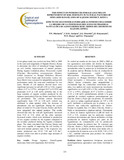| dc.description.abstract | A two phase study was carried out from 2002 to 2005 in the semi-arid rangelands of Kajiado District, Kenya to determine the effect of introduced forage legumes on soil fertility improvement of natural pastures. During legume evaluation phase, Neonotonia wightii (Glycine), Macroptilium atropurpureum (Siratro), Lablab purpureus cv. Rongai (Dolichos), Mucuna pruriens (Velvet bean) and Stylosanthes scabra var. Seca (Stylo) were screened for adaptability and growth performance under the semi-arid conditions for two years. Results of soil analysis showed there were significant increases in soil pH (4.92 to 5.36), organic carbon (1.17 to 2.57%) , nitrogen (0.17 to 0.22%) and potassium (1.23 to 1.68 me%) probably due to the large amounts of organic residues produced by the legumes (particularly Glycine, Siratro and Stylo which are perennials). The calcium content decreased significantly from 7.97 to 4.50 me% (which was attributed to plant uptake) while the decrease of phosphorus was not significant. During the second phase of study for 1½ years Glycine, Siratro and Stylo were integrated into natural pastures. The results showed that only the soil pH significantly increased from 5.23 to 5.31 while all the other nutrients decreased results, which were attributed to production of less organic residues by the legumes compared to the residues produced during the legume evaluation phase. The study concluded that Glycine, Siratro and Stylo were capable of improving the soil fertility of semi-arid natural pastures only if the respective dry matter production was 10.31, 7.81 and 3.52 tha-1, amounts which were able to produce large amounts of organic residues. | en |

